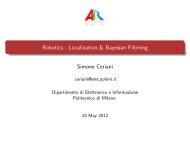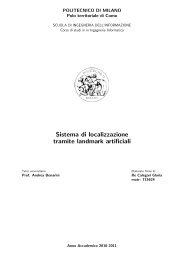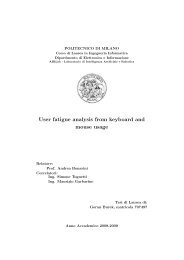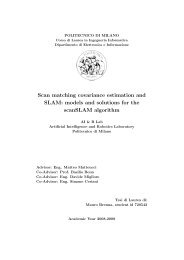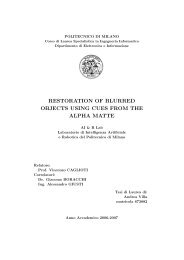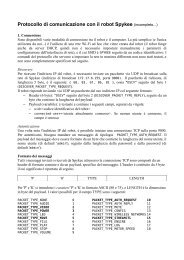Submitted version of the thesis - Airlab, the Artificial Intelligence ...
Submitted version of the thesis - Airlab, the Artificial Intelligence ...
Submitted version of the thesis - Airlab, the Artificial Intelligence ...
You also want an ePaper? Increase the reach of your titles
YUMPU automatically turns print PDFs into web optimized ePapers that Google loves.
36 Chapter 3. Mechanical Construction<br />
ized that <strong>the</strong> boards were configured to work at 8 V. This forced us to make<br />
<strong>the</strong> decision <strong>of</strong> buying new batteries or new control circuits. Evaluating <strong>the</strong><br />
prices, we ended up buying new control circuits that are rated for 5 V.<br />
MC33887 motor driver integrated circuit is an easy solution to connect<br />
a brushed DC motor running from 5 to 28 V and drawing up to 5 A (peak).<br />
The board incorporates all <strong>the</strong> components <strong>of</strong> <strong>the</strong> typical application, plus<br />
motor-direction LEDs and a FET for reverse battery protection. A microcontroller<br />
or o<strong>the</strong>r control circuit is necessary to turn <strong>the</strong> H-Bridge on and<br />
<strong>of</strong>f. The power connections are made on one end <strong>of</strong> <strong>the</strong> board, and <strong>the</strong> control<br />
connections (5V logic) are made on <strong>the</strong> o<strong>the</strong>r end. The enable (EN) pin<br />
does not have a pull-up resistor, so it be must pulled to +5 V in order to<br />
wake <strong>the</strong> chip from sleep mode. The fault-status (FS, active low) output pin<br />
may be left disconnected if it is not needed to monitor <strong>the</strong> fault conditions <strong>of</strong><br />
<strong>the</strong> motor driver; if it is connected, it must use an external pull-up resistor<br />
to pull <strong>the</strong> line high. IN1 and IN2 control <strong>the</strong> direction <strong>of</strong> <strong>the</strong> motor, and<br />
D2 can be PWMed to control <strong>the</strong> motor’s speed. D2 is <strong>the</strong> ”not disabled“<br />
line: it disables <strong>the</strong> motor driver when it is driven low (ano<strong>the</strong>r way to think<br />
<strong>of</strong> it is that, it enables <strong>the</strong> motor driver when driven high). Whenever D1<br />
or D2 disable <strong>the</strong> motor driver, <strong>the</strong> FS pin will be driven low. The feedback<br />
(FB) pin outputs a voltage proportional to <strong>the</strong> H-Bridge high-side current,<br />
providing approximately 0.59 volts per amp <strong>of</strong> output current.<br />
Voltage Divider and Voltage Regulator Circuit<br />
Batteries are never at a constant voltage. For our case 7.2 V battery will<br />
be at around 8.4 V when fully charged, and can drop to 5 V when drained.<br />
In order to power microcontroller (and especially sensors) which are sensitive<br />
to <strong>the</strong> input voltage, and rated to 5 V, we need a voltage regulator<br />
circuit to output always 5 V. The design <strong>of</strong> <strong>the</strong> circuit that will be used in<br />
voltage regulation merged with <strong>the</strong> voltage divider circuit that will be used<br />
for battery charge monitor shown in Figure 3.16.<br />
To operate voltage divider circuit, <strong>the</strong> following equation is used to determine<br />
<strong>the</strong> appropriate resistor values.<br />
Vi<br />
Vo = ∗R2<br />
R1 +R2<br />
Vi is <strong>the</strong> input voltage, R1 and R2 are <strong>the</strong> resistors, and Vo is <strong>the</strong> output<br />
voltage.




